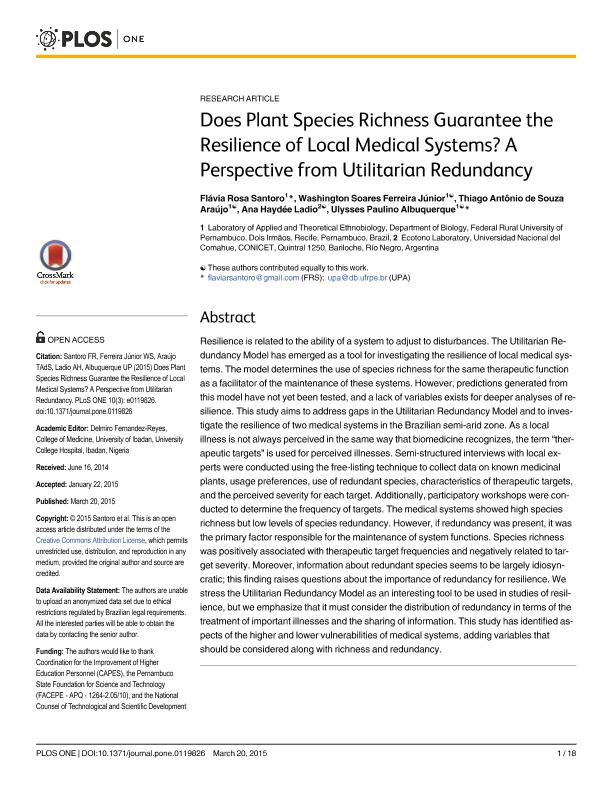Mostrar el registro sencillo del ítem
dc.contributor.author
Santoro, Flávia Rosa
dc.contributor.author
Ferreria Júnior, Washington Soares
dc.contributor.author
Araujo, Thiago Antônio de Souza
dc.contributor.author
Ladio, Ana Haydee

dc.contributor.author
Albuquerque, Ulysses Paulino
dc.date.available
2017-01-26T20:41:13Z
dc.date.issued
2015-03
dc.identifier.citation
Santoro, Flávia Rosa; Ferreria Júnior, Washington Soares ; Araujo, Thiago Antônio de Souza; Ladio, Ana Haydee; Albuquerque, Ulysses Paulino; Does Plant Species Richness Guarantee the Resilience of Local Medical Systems? A Perspective from Utilitarian Redundancy; Public Library of Science; Plos One; 10; 3; 3-2015; 1-18
dc.identifier.issn
1932-6203
dc.identifier.uri
http://hdl.handle.net/11336/12038
dc.description.abstract
Resilience is related to the ability of a system to adjust to disturbances. The Utilitarian Redundancy Model has emerged as a tool for investigating the resilience of local medical systems. The model determines the use of species richness for the same therapeutic function as a facilitator of the maintenance of these systems. However, predictions generated from this model have not yet been tested, and a lack of variables exists for deeper analyses of resilience. This study aims to address gaps in the Utilitarian Redundancy Model and to investigate the resilience of two medical systems in the Brazilian semi-arid zone. As a local illness is not always perceived in the same way that biomedicine recognizes, the term “therapeutic targets” is used for perceived illnesses. Semi-structured interviews with local experts were conducted using the free-listing technique to collect data on known medicinal plants, usage preferences, use of redundant species, characteristics of therapeutic targets, and the perceived severity for each target. Additionally, participatory workshops were conducted to determine the frequency of targets. The medical systems showed high species richness but low levels of species redundancy. However, if redundancy was present, it was the primary factor responsible for the maintenance of system functions. Species richness was positively associated with therapeutic target frequencies and negatively related to target severity. Moreover, information about redundant species seems to be largely idiosyncratic; this finding raises questions about the importance of redundancy for resilience. We stress the Utilitarian Redundancy Model as an interesting tool to be used in studies of resilience, but we emphasize that it must consider the distribution of redundancy in terms of the treatment of important illnesses and the sharing of information. This study has identified aspects of the higher and lower vulnerabilities of medical systems, adding variables that should be considered along with richness and redundancy.
dc.format
application/pdf
dc.language.iso
eng
dc.publisher
Public Library of Science

dc.rights
info:eu-repo/semantics/openAccess
dc.rights.uri
https://creativecommons.org/licenses/by/2.5/ar/
dc.subject
Resilience
dc.subject
Brasil
dc.subject
Medicinal Knowledge
dc.subject
Plants
dc.subject.classification
Otras Ciencias Biológicas

dc.subject.classification
Ciencias Biológicas

dc.subject.classification
CIENCIAS NATURALES Y EXACTAS

dc.title
Does Plant Species Richness Guarantee the Resilience of Local Medical Systems? A Perspective from Utilitarian Redundancy
dc.type
info:eu-repo/semantics/article
dc.type
info:ar-repo/semantics/artículo
dc.type
info:eu-repo/semantics/publishedVersion
dc.date.updated
2016-12-12T14:22:28Z
dc.journal.volume
10
dc.journal.number
3
dc.journal.pagination
1-18
dc.journal.pais
Estados Unidos

dc.journal.ciudad
San Francisco
dc.description.fil
Fil: Santoro, Flávia Rosa. Universidade Federal Rural Pernambuco. Departamento de Biologia. Laboratorio de Etnobotanica Aplicada; Brasil
dc.description.fil
Fil: Ferreria Júnior, Washington Soares . Universidade Federal Rural Pernambuco. Departamento de Biologia. Laboratorio de Etnobotanica Aplicada; Brasil
dc.description.fil
Fil: Araujo, Thiago Antônio de Souza. Universidade Federal Rural Pernambuco. Departamento de Biologia. Laboratorio de Etnobotanica Aplicada; Brasil
dc.description.fil
Fil: Ladio, Ana Haydee. Consejo Nacional de Investigaciones Científicas y Técnicas. Centro Científico Tecnológico Patagonia Norte. Instituto de Investigación En Biodiversidad y Medioambiente; Argentina. Universidad Nacional del Comahue. Centro Regional Universitario Bariloche. Laboratorio de Ecotono; Argentina
dc.description.fil
Fil: Albuquerque, Ulysses Paulino. Universidade Federal Rural Pernambuco. Departamento de Biologia. Laboratorio de Etnobotanica Aplicada; Brasil
dc.journal.title
Plos One

dc.relation.alternativeid
info:eu-repo/semantics/altIdentifier/url/http://journals.plos.org/plosone/article?id=10.1371/journal.pone.0119826
dc.relation.alternativeid
info:eu-repo/semantics/altIdentifier/doi/http://dx.doi.org/10.1371/journal.pone.0119826
Archivos asociados
